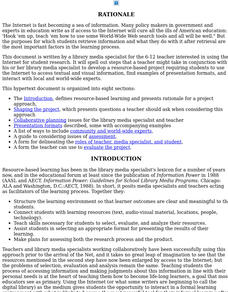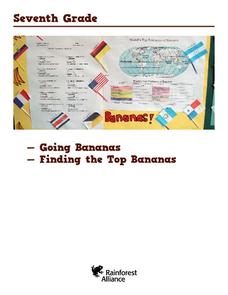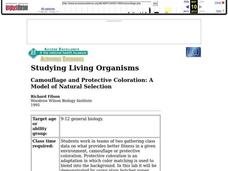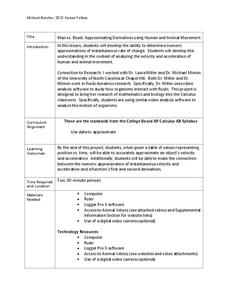Curated OER
Geography Made Fun with Technology
Young scholars incorporate knowledge box into their classroom activities. In this technology integration lesson, students fill out a graphic organizer using Glossopedia to analyze a new subject.
Curated OER
Plant Reproduction
Students identify the different parts and function of a flower's reproductive system. In this biology lesson, students explain how pollination works. They watch a video and practice labeling parts of both flower and leaf.
Curated OER
Ambush Warriors
Middle schoolers identify four different categories of reptiles and explain how snakes deliver their venom to their prey.
Curated OER
Rosa Parks
Students complete a variety of written and discussion activities regarding Rosa Parks and the Alabama bus boycott and how they changed an accepted way of life in America.
Curated OER
Narrative Prompt
Students write to describe a summer activity. They read a book about the seasons. They describe grab bag props and how they are used in summer.
Curated OER
ETHICAL USE OF THE INTERNET
High schoolers investigate the use of the internet and how it should be used by students. The concepts of intellectual property and fair usage are covered. The author of resources is found by them through practice with finding small...
Curated OER
Coming to America
Students examine the various cultures of the immigrants who came to America. Using the internet, they research various ethnic and cultural groups within the United States. They identify the reasons why people immigrated to the U.S. and...
Curated OER
Journey of the Salmon
Third graders predict salmon migration routes and explore how dams affect the salmon migration. They explore the cultural significance of salmon to the Nez Perce people and design technology to aid salmon migration.
Curated OER
Comparing Northwest Native American Communities
Students review how to use the database from previous lessons. Using the information, they identify the historical and environmental effects on the people living in the Pacific Northwest. They examine the various Native American groups...
Curated OER
Who Stole My Salad?
Eighth graders explain how protein is made in the cell. In this biology lesson, 8th graders translate RNA and DNA using an internet database. They determine the thief based on evidence collected.
Curated OER
Rationale
Students consider the rationale behind using the Internet as a research resource tool. They develop a research project, consider how to access and assess new information and format their research for presentation to the class.
Curated OER
Finding Longitude and Latitude on Pennsylvania Maps
Students draw the lines of longitude and latitude on a map. Students look at a topographical maps to see how topography relates to land use.
Curated OER
Tall Grass Prairies of Arkansas
Students compare maps depicting the past and present range of tall grass prairie in Arkansas. They research to discover what has happened to the prairie, why it is unique, how it contributes to the biodiversity of Arkansas, and why...
Curated OER
Conducting Research
Fourth graders write informational research reports. They are given a worksheet on conducting research. Students are told that they are going to write a research report about trains. They review the list of trains and discuss how each...
Curated OER
Honduras: Going Bananas
Students explore the popularity of bananas. They conduct a survey to understand the reasons for their popularity. Students research a banana's journey from the farm to school lunch. They compose a children's book about bananas explaining...
Curated OER
Camouflage and Protective Coloration: A Model of Natural Selection
Students collect data and compare whether protective coloration or camouflage provides better biological fitness in a given environment. They simulate predator prey interactions of two different species and use gene frequencies to...
Curated OER
The Very Hungry Caterpillar
Second graders watch a video about Eric Carle before listening to his story entitled, The Very Hungry Caterpillar. They notice how the caterpillar eats its way through the days of the week and they examine the life cycle of the...
Curated OER
Furbearers of Illinois
Students study fur bearing animals of Illinois. They research a specific furbearer (it's habitat, diet, current hunting regulations regarding the animal, conservation organizations that help the animal, etc.) and give a presentation on...
Curated OER
Wh0-o-o-o's Out There?
Fifth graders describe the physical features of an owl and identify survival adaptations. They Investigate an owl's niche in an ecosystem. The students participate in an interactive puzzle on the internet that helps for motivation.
Curated OER
The Five Senses
Students explore and study about the five senses. They focus on their sense of smell and interact with certain ingredients, including white vinegar. Each student also helps to create and share a concept map on the sense of smell...
Curated OER
Is It A Bird?
In this bird characteristics worksheet, students compare the characteristics of bats and penguins to those of birds, then draw conclusions about whether bats/penguins are birds. General characteristics of birds are given in the first...
Curated OER
Building Aqueducts
Young scholars simulate building a Roman aqueduct using an interactive website. In this social studies lesson plan, students design their own class aqueduct. They construct one inside the science classroom.
Curated OER
Breaking News English: Site for Beautiful People Only
In this English worksheet, students read "Site for Beautiful People Only," and then respond to 1 graphic organizer, 47 fill in the blank, 7 short answer, 20 matching, and 8 true or false questions about the selection.
Kenan Fellows
Man vs. Beast: Approximating Derivatives using Human and Animal Movement
What does dropping a ball look like as a graph? An engaging activity asks learners to record a video of dropping a ball and uploading the video to software for analysis. They compare the position of the ball to time and calculate the...

























